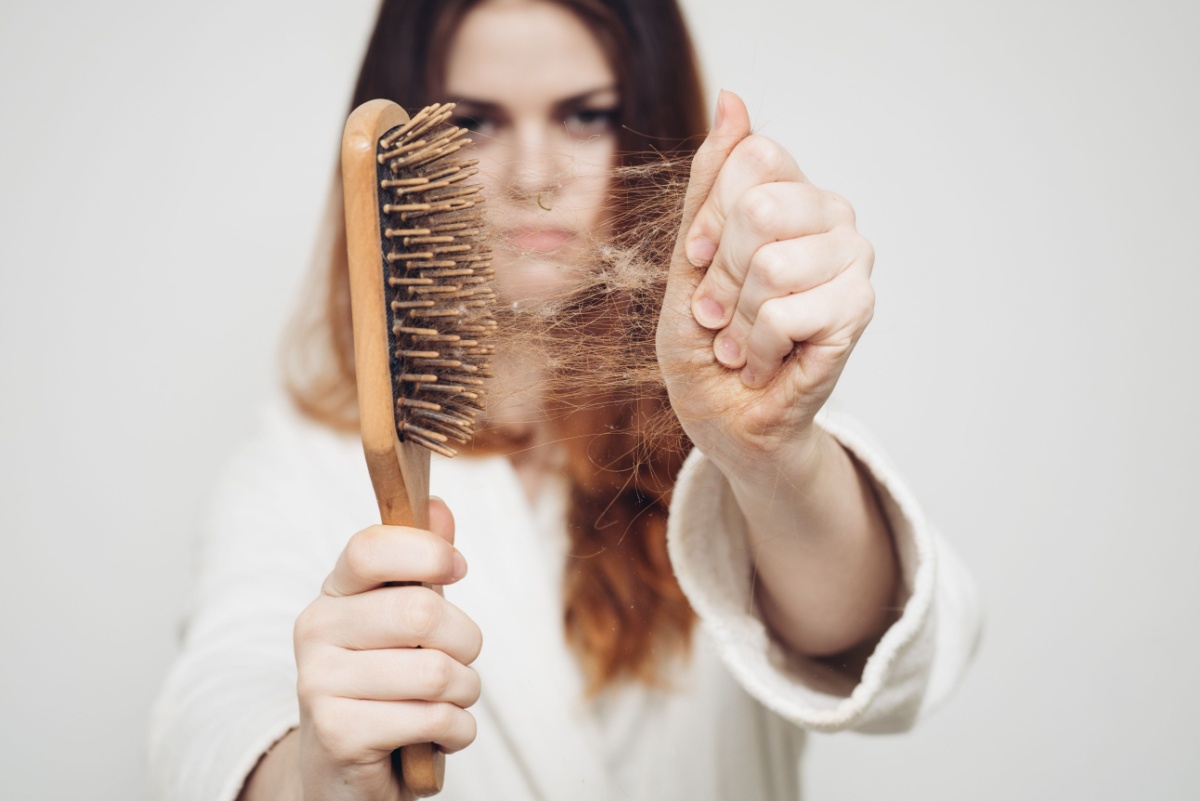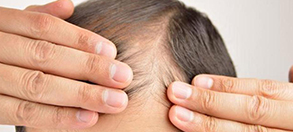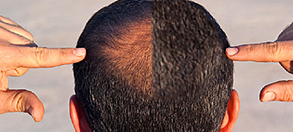Hair loss following infection with Covid-19 is a common side effect being experienced by a significant percentage of people in the U.S. and worldwide during the pandemic. In addition to experiencing respiratory difficulty, fever, fatigue, and other common symptoms, hospitals continue to report hair loss in many patients. In fact, data published in The Lancet reveals that over 20% of men and women hospitalized with Covid-19 lose hair within 3-6 months of their discharge.(1) That’s almost one in five patients.
Hair loss can occur for many different reasons, but thinning hair after Covid-19 infection can be classified as a condition known as telogen effluvium (TE). Recent studies confirm that infection with the disease is a significant cause of acute telogen effluvium, and is now one of the most frequent and common causes of the condition.(2) Covid-19, a novel coronavirus, continues to present medical challenges worldwide. However, thanks to dedicated scientists, physicians, and other individuals in the medical profession, help is at hand.
Dr. Goran Jezic provides comprehensive hair restoration services for men and women who are experiencing hair loss. As a hair restoration professional, he has adapted to the challenges of the global health crisis by tailoring effective solutions for the residents of Houston, Texas, and beyond. If you believe your hair loss is Covid-related, or if you suffer from hair thinning, pattern baldness, or patchiness, please arrange a personal consultation. Call (713) 864-2300 or complete the simple inquiry form on our website. If you are not able to attend your appointment in person, Dr. Jezic is happy to offer convenient virtual consultations to his patients.
The Hair Cycle
Hair grows on almost every part of the body. All hair, including the hair on our scalp, goes through a cycle of growth with several stages. Scalp hair, and hair under the armpits and in the genital area consist of terminal hair. Terminal hair is longer, thicker, and darker than vellus hair, which is shorter and finer, and lanugo, the hair that covers our bodies when we are born. The hair cycle has three distinct stages:
Stage One: The Anagen (Growing) Phase – During the growing phase, the hair follicle has a direct blood supply. The hair matrix at the base of the structure connects with the vascularized hair papilla, a collection of cells just under the hair follicle. This provides nutrients for the hair to enable it to grow. The hair is secured at the root as rapid cell division occurs and the hair becomes longer. Active hair growth can occur for 2-6 years.
Stage Two: The Catagen (Transition) Phase – The hair stops growing in the catagen phase. The follicle slowly detaches from its blood supply in preparation for shedding. Apoptosis, the medical term for cell death, occurs and the hair follicle becomes inactive. This process can take between 2-4 weeks.
Stage Three: The Telogen (Resting) Phase – In the final phase, the dead hair falls out. The hair follicle resets completely and prepares its stem cells to start the next growth phase and form a new hair shaft.(3) The telogen phase can last between 3-5 months.
Stress, Disease, and Hair Loss
Hair loss can occur for many reasons. Some of the most well-known are:
- Androgenetic Alopecia (male pattern balding)
- Hormonal Changes
- Dietary Deficiencies
- Medications
- Radiation therapy
- Trauma (injury, damaging hairstyles)
Patients often report hair loss during periods of excessive stress. Although doctors check for underlying diseases, frequently hair loss is the only ailment found.(4)
How Can Covid-19 Affect the Hair Cycle?
Covid-19 can cause acute telogen effluvium in some sufferers of the virus. Patients experience TE 2 to 3 months following stressful events, including viral infection.(2) Recent research shows that Covid-19 appears to increase the body’s production of inflammatory cytokines, cells whose main functions are growth regulation and cell activation. Though the exact relationship between Covid-19 and TE is unknown, it is thought to be caused by a “cytokine storm” triggered by the virus. A cytokine storm is a serious immune reaction that can cause damage to tissues and organs.
Hair Restoration After Covid
For some people, TE is not permanent. After a few months, the hair resets and resumes its growth cycle as expected. However, some men and women may find their hair never regains its full thickness, especially if they suffer from androgenetic alopecia. Dr. Jezic offers hair restoration techniques that can help.
Minoxidil
Minoxidil, also known as Rogaine, is a topical hair-loss treatment. For many patients with mild to moderate thinning, it’s the first treatment to turn to. It promotes hair growth by targeting follicular cells.
Facts About Minoxidil
- No prescription required
- Available in 2% and 5% formulations
- Liquid or foam preparation
- Approved for women’s hair loss
- Easy to apply
Minoxidil enhances growth and reduces hair loss by shortening the telogen phase of the hair growth cycle and induces the anagen phase. After treatment, patients can see progressive hair loss after 12-24 weeks.(5)
Finasteride
If Minoxidil treatment has not been successful, some people opt to treat their hair loss with Finasteride (Propecia). Finasteride reduces levels of 5-alpha-reductase, the enzyme responsible for dihydrotestosterone (DHT), which plays a significant role in male pattern baldness.
Facts About Finasteride
- Prescription medication
- Oral preparation (pill)
- Typical dosage 1mg/day
- Indicated for men with androgenetic alopecia
- Also treats enlarged prostate
- Improvements after 3-6 months
Please note that Finasteride is not indicated for use in women of childbearing age.(6)
Autologous Conditioned Plasma (ACP)
ACP injections support hair regrowth by using a patient’s own blood plasma. After drawing around 20 cc of blood, the vial is spun in a centrifuge, where it separates into its component parts. Plasma rich in restorative properties is isolated and extracted from the treated blood, then reintroduced to the scalp to stimulate new hair growth. Many patients receive ACP treatment as a supplement to follicular unit extraction (FUE) hair transplant.
ATERA FUE & NeoGraft
Follicular unit extraction (FUE) hair transplants utilize the latest hair restoration techniques. A hair transplant may be necessary for patients who already have androgenetic alopecia in addition to Covid-related hair loss. Surgeons harvest individual grafts consisting of 1 to 3 hair follicles from a donor area, then graft the units to the location of hair loss. The newly implanted hair stimulates the follicles to produce their own hair. At Houston Hair Transplant Center, we offer two effective FUE treatments. The ATERA FUE system is a machine that performs minimally-invasive hair transplants through different size punches. The handpiece is depth-controlled for easy harvesting of the most viable grafts. The NeoGraft hair transplant system leaves no linear scarring and produces effective results with minimal downtime!
Personal Consultation
Your personal hair loss consultation with Dr. Jezic will give you the opportunity to speak frankly about your condition and how it is affecting your life. He applies care and sensitivity to every patient to find the right hair restoration treatment for their unique needs. If your hair loss occurred after you contracted Covid-19, please discuss the details of your experience with him. After he has taken details about your medical history and examined your scalp thoroughly, he will note the areas of hair loss and assess whether the problem is localized or diffuse. He will then run through the benefits of each of the hair restoration treatments he thinks will be most effective for you.
Don’t wait to address Covid-related hair loss. Call Houston Hair Transplant Center today at (713) 864-2300 to book your individual appointment with Dr. Jezic. Alternatively, you can fill out a quick inquiry form on our website with your request.
Cost of Hair Restoration Treatments in Houston, TX
The cost of hair restoration treatment varies according to the condition you wish to treat and the extent of your hair loss. A personal consultation with Dr. Jezic will quickly and accurately inform your hair restoration decisions. Each hair restoration procedure has a different application, equipment, and technique, so costs vary.
Get the latest hair restoration news by reading Dr. Jezic’s blog and stay informed by joining Houston Hair Transplant Center on Instagram and Facebook.
FAQ
Can Covid-19 cause hair loss?
There is increasing scientific evidence to show that Covid-19 can cause hair loss in men and women who have contracted the virus. Studies show that as many as 20% of hospitalized Covid-19 patients experienced hair loss in the months after they were discharged from the hospital.
What kind of doctor should I speak to about hair loss from Covid?
Speak to your primary care provider if you notice increased hair shedding after contracting Covid-19. They may refer you to a hair specialist. In more severe cases of hair loss, restoration treatment may be required. This can be performed by a hair restoration specialist after a thorough evaluation of your symptoms.
Does Covid affect women’s hair as well as men’s hair?
Recent research studies confirm that both men and women can suffer excessive hair loss due to Covid-19. Telogen effluvium is a condition that can affect people after they contract the virus. It causes the hair follicle to be “stuck” in the resting (telogen) stage of the hair growth cycle.
References
- Huang, C., Huang, L., Wang, Y., Li, X., Ren, L., Gu, X., Kang, L., Guo, L., Liu, M., Zhou, X., Luo, J., Huang, Z., Tu, S., Zhao, Y., Chen, L., Xu, D., Li, Y., Li, C., Peng, L., & Li, Y. (2021). 6-month consequences of COVID-19 in patients discharged from hospital: a cohort study. The Lancet, 0(0). https://doi.org/10.1016/S0140-6736(20)32656-8
- Sharquie, K. E., & Jabbar, R. I. (2021). COVID-19 infection is a major cause of acute telogen effluvium. Irish Journal of Medical Science (1971 -). https://doi.org/10.1007/s11845-021-02754-5
- Alonso, L., & Fuchs, E. (2006). The hair cycle. Journal of Cell Science, 119(3), 391–393. https://doi.org/10.1242/jcs.02793
- Peters, E. M. J., Müller, Y., Snaga, W., Fliege, H., Reißhauer, A., Schmidt-Rose, T., Max, H., Schweiger, D., Rose, M., & Kruse, J. (2017). Hair and stress: A pilot study of hair and cytokine balance alteration in healthy young women under major exam stress. PLOS ONE, 12(4), e0175904. https://doi.org/10.1371/journal.pone.0175904
- Suchonwanit, P., Thammarucha, S., & Leerunyakul, K. (2019). Minoxidil and its use in hair disorders: a review. Drug Design, Development and Therapy, Volume 13, 2777–2786. https://doi.org/10.2147/dddt.s214907
- Iorizzo, M., Vincenzi, C., Voudouris, S., Piraccini, B. M., & Tosti, A. (2006). Finasteride Treatment of Female Pattern Hair Loss. Archives of Dermatology, 142(3), 298–302. https://doi.org/10.1001/archderm.142.3.298




